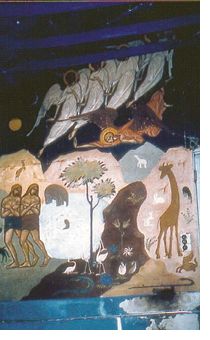 The road to icon-painting was simple and direct. The childhood of a child of a noble family in the years before the Revolution - with a nanny, a maid, foreign languages and the gymnasium' and before she finished the 8th class to art school, the Society for the Advancement of Artists; during this time, her grandfather, having dropped the proud prefix 'von' from the surname of the barons Reitlinger and the deep piety of her mother visiting the small domestic church by the museum of Alexander III. Then - 'exile': the Crimea, the death of her nearest and dearest, and then Warsaw, Prague, Belgrade, and from 1925 onwards - Paris. In the Crimea in 1918 she made the acquaintance of Fr Sergei Bulgakov which determined the direction and meaning of the whole of the rest of her life. In Paris, Yu. N. Reitlinger settled in the attic of the St Sergius Monastery / institute (church and house) above the rooms of Father Sergei, and was guardian to him and his wife until their deaths in 1944 and 1945. The road to icon-painting was simple and direct. The childhood of a child of a noble family in the years before the Revolution - with a nanny, a maid, foreign languages and the gymnasium' and before she finished the 8th class to art school, the Society for the Advancement of Artists; during this time, her grandfather, having dropped the proud prefix 'von' from the surname of the barons Reitlinger and the deep piety of her mother visiting the small domestic church by the museum of Alexander III. Then - 'exile': the Crimea, the death of her nearest and dearest, and then Warsaw, Prague, Belgrade, and from 1925 onwards - Paris. In the Crimea in 1918 she made the acquaintance of Fr Sergei Bulgakov which determined the direction and meaning of the whole of the rest of her life. In Paris, Yu. N. Reitlinger settled in the attic of the St Sergius Monastery / institute (church and house) above the rooms of Father Sergei, and was guardian to him and his wife until their deaths in 1944 and 1945.
Before her repatriation in 1955, she lived in the circle of the spiritual children of Father Sergei and maintained contact with them afterwards.
In her autobiography , Yu. N. Reitlinger remembered: ' It was virtually a monastic way of life, meeting Father Sergei, daily attendance at church - but still the world overflowed into it, seductive temptations knocked one off one's feet. Somehow, I had to strengthen my way. A convent - no, my vocation was to be a free artist. The example of Mother Maria (Kuz'mina-Karavaeva) showed the possibilities: to stay where I was, to take the veil and get on with my painting. Bishop Evlogiy (Metropolitan of the Russian Church Abroad) gave me his blessing. 'But,' he said - 'You are young, mother (the wife of Fr. Sergei) is old. Be a daughter to her - how is she then going to call you 'Matyushka' - that won't do. I will ordain you to the habit, but I'll change your name...' 
|
